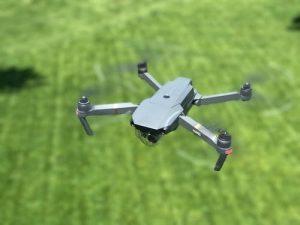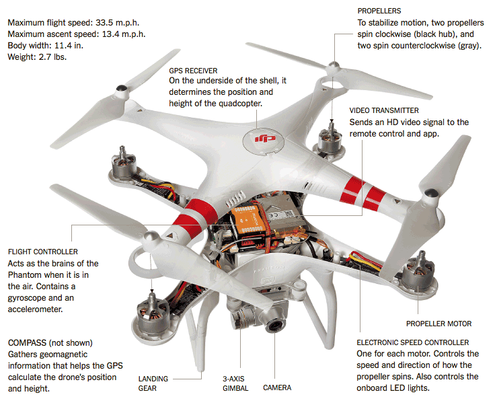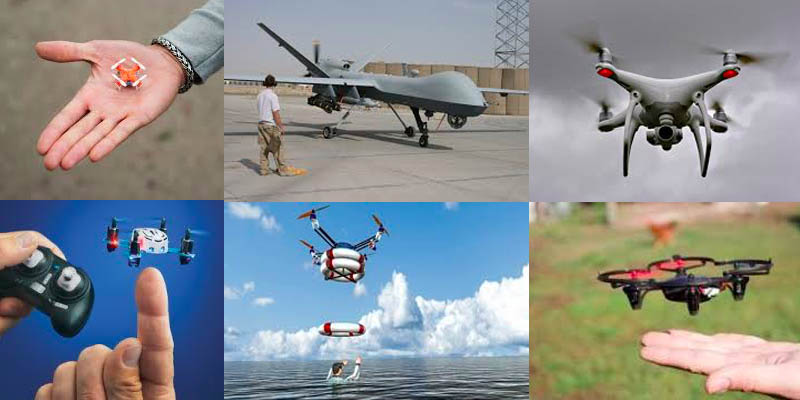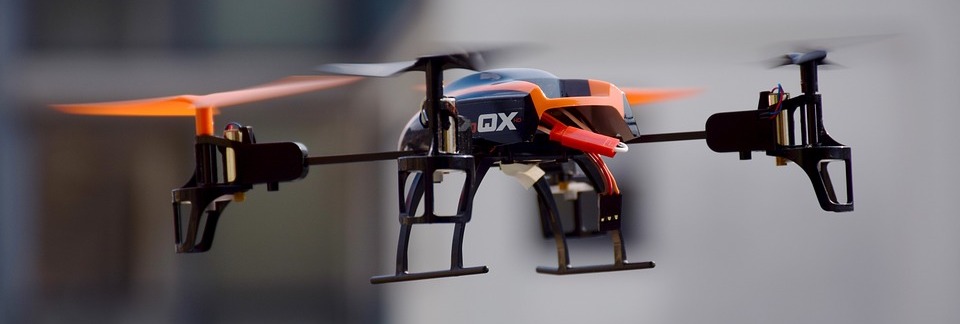Beginner’s Guide to Drones
Have you been wondering how your Instagram friend can just casually take aerial photos of their trips to the beach? Perhaps you have seen news items or movies where military operations are carried out using unmanned aerial vehicles (UAVs). What is drone technology and how does it work?
Drone flight has gained wide popularity with hobbyists and aerial photography enthusiasts. Beyond casual use, drones have even been used for military, industrial, and commercial purposes. What does it take to get into this hobby? If you’re considering taking up the hobby and buying your first drone, you will want to read up.
What are Drones?

The word “drone” has entered the modern lexicon to refer to a range of unmanned aerial vehicles that are operated autonomously or remotely controlled. Despite its recent surge in popularity, the technology behind drones really isn’t anything new. The remote control system for drones is no different to those used by remote control cars and airplanes that came into fashion in the late 70’s to early 80’s. Technically, those old R/C cars and planes can be classified as drones by merit of them being unmanned vehicles.
Battery, motor, and camera technology has improved drastically in recent years, which has lead to a surge in the popularity of drones. Prices for quality drones has also dropped making it a much cheaper hobby to pick up.
Nowadays, drones almost exclusively allude to unmanned aerial vehicles (UAV’s) equipped with some form of image or video capture technology. UAV’s used for military purposes are usually more specialized, with capabilities for pre-programmed navigation and delivery of armed payloads. The drones used by hobbyists are mostly quadcopters, which the rest of this article will put more focus on.
As its name implies, quadcopters are helicopters propelled by four rotors. The vertical lift provided by the multiple rotors gives the quadcopters the ability to hover in a single spot, making them the drone type of choice for aerial photography. This is in contrast to R/C fixed-wing airplanes which rely on its forward airspeed to generate lift, requiring it to keep moving to stay airborne.
The ease of control and the relative simplicity of construction of quadcopters have made them more popular compared to fixed-wing airplanes and conventional helicopters. Having two pairs of rotors spinning at different directions solves the torque imbalance inherent in the conventional helicopter models, while also providing a simple mechanism for movements such as turning and pitching.
Drones are commonly made with light composite material, decreasing the power requirement for flight and increasing maneuverability. Whether used for personal or commercial uses, most drones contain a wide array of equipment onboard such as cameras, Global Positioning Systems (GPS), video transmitters, and other specialized sensors. With rapidly improving technology, it seems that we are not even halfway to fully exploring the potential of drone flight.
How Do Drones Work?

To fully appreciate how drones work, we must first understand how it’s made and the essential component s in its construction. The basic components of a drone are as follows:
Frame
As mentioned, the frame is commonly made of sturdy but lightweight composite material such as plastic (in cheap models), fiber glass, or carbon fiber, but low-density metals such as aluminum and titanium are also used. The frame provides the central hub that houses the electronics mounted in the drone. Almost all quadcopter frames have a central hub from which spokes radiate outwards. It is on these spokes that the rotors are mounted.
The frame needs to provide a water-proof encasement for the motor. Some models also incorporate rotor guards to the frame, protecting the rotor from damage and also making the drone safer to handle for the operator.
Propellers
The propellers are responsible for all aspects of drone movement – whether it be stationary hovering, turning, tilting, or moving forward and backward. Aside from providing vertical lift, variations in the rotational speed of individual rotors allow the drone to make very fine and responsive maneuvers. Most drone propellers are made of plastic, while the more expensive models have propellers made of carbon fiber.
Motor
The motor provides the rotational power to the rotors. Many drones use brushless motors which are more efficient to brushed motors because of the decreased loss of energy due to friction between the brushes of the motor commutator. The increased efficiency is very important in saving battery life, therefore giving longer flying times.
Battery
The battery used to power the rotors and other onboard electronics in a drone is commonly the lithium polymer type. “Li-Po” batteries are known for being small and lightweight, with high energy density and high discharge rate. They can be quite tricky to handle and store compared to more conventional batteries, but Li-Po batteries have traits that make them uniquely appropriate for drone flight.
Camera
The most widely used and popular brand of cameras used in drone photography is definitely GoPro, which provides compact and high definition cameras with a variety of special capabilities (e.g. fisheye, wide-angle, etc).
Gimbal
Having a very good camera will be worthless without a mechanism to provide image stabilization, as cameras mounted on drones are subject to a great deal of auxiliary movement and vibrations. Gimbals have dampeners that neutralize the effect of vibrations when taking photos or video, avoiding issues such as jello effect and rolling shutters. Gimbals also provide the mechanism by which cameras can rotate in three dimensions.
Electronic Speed Controllers
The electronic speed controller (ESC) serves to control the speed of the motor and its direction. It allows for smoother variations in motor speed, which is crucial in navigating your drone.
Global Positioning System (GPS) Module
Most drone models incorporate a GPS receiver which can provide information on position, elevation, and compass heading. This allows for safer and more accurate flight, and also allows the user to set a failsafe home point that the drone will return to if it ever loses radio contact. GPS modules are absolutely necessary for setting waypoints should autonomous drone flight be desired.
Receiver
The receiver interfaces with the transmitter to interpret the navigation instructions from the drone pilot. It is often just a standard radio signal receiver equipped with 4 or 5 channels.
Flight Controller
The flight control integrates all the inputs from the receiver, ESC, GPS module, battery monitor, and any other onboard sensors. It acts as the central “brain” of the drone, giving orders to regulate motor speed, vary rotor speeds to navigate, trigger cameras, initiate autopilot navigation to waypoints, and activate failsafe measures.
Landing gear
Depending on the model, drones can have either fixed or retractable landing gears. Landing gear can help in protecting the sensitive electronics onboard the drone, and may be necessary in models with hanging payloads. Retractable landing gears are most preferred, as they will not interfere with photos and videos taken while the drone is airborne. There are a few models that can land perfectly fine on their bodies and have no landing gears.
Other sensors
Depending on the purpose, drones can have a multitude of optional sensors mounted on them. Aside from cameras, drones can be equipped with an array of laser or thermal sensors to generate various types of information. The applications of these specialized remote sensing techniques are discussed later.
What Can Drones Do?

Outside of hobbyists using drone for casual flight and capture of aerial photos and videos, drones have been used for various military, commercial, and industrial purposes.
Military – Drones can be used for military purposes in cases where sending a manned aircraft is deemed unsafe or impractical. Military drones gained wide notoriety when they were widely used by the US military to conduct reconnaissance surveys and to deliver armed payloads to enemy territories in Afghanistan and Pakistan during the “War on Terror”. Drones have also been used for crowd control using non-lethal weapons such tear gas or sound cannons.
Delivery of goods – Big shipping companies such as Amazon and DHL have started adopting the use of drones for delivery of their products. These delivery drones are equipped with a claw and are able to gently drop items remotely to a desired target area. The use of drones for delivery can greatly speed up shipping of items, as well as save on overhead and operating expenses.
Journalism and filmmaking – Drone footage has been a low-cost solution to capturing aerial shots for use in professional and amateur films. Major media outlets have also used drone to capture footage in events where an aerial perspective is highly useful, such as mass protests, floods, and wars.
Drone racing – A competitive sport has been developed where drones race along a pre-defined course. These drone racing events may be conducted indoor or outdoor, and place special emphasis on obstacles requiring advanced maneuvers. Most competitive drones are custom-built by their users with due consideration for speed, weight, and agility.
Surveying of buildings and construction sites – Obtaining overview and close up images of buildings and construction sites is probably the biggest commercial application of drones nowadays. Through the use of drones, there is no need for actual people to do the hazardous job of scaling up buildings to conduct surveys. Drones can get high definition photos of buildings and structures with so much accuracy that the imagery can be used to generate three dimensional models.
Remote sensing – Aside from casual enthusiasts, drone photography has also been used by professionals to generate three-dimensional terrain models of areas that are otherwise inaccessible. Mapping using the technology of Light Detection and Ranging (LiDAR) generates a topography model or digital elevation model (DEM) via range values generated by a drone-mounted pulsing laser detector. Compared to satellite imagery, footage captured by drones provides much higher resolution aerial images and topography models.
Search and rescue – There have been several stories where successful search and rescue missions were carried out in large part with the help of drone footage. Drones provide rapid reconnaissance of inaccessible areas especially in disasters such as floods and earthquakes. Compared to human search and rescue teams, drones don’t get exhausted or get lost.
Atmospheric science – Drones are especially suitable for the airborne collection of atmospheric data. Global Hawk, the drone used by NASA to probe for hurricane activity, has collected valuable atmospheric information through aerial imagery. Researchers at Oklahoma have also used drones to measure the lower atmosphere so they can issue tornado warnings 20 to 60 minutes earlier than usual.
Environmental and ecological applications – High definition images captured using drones can be used to assess the degree of erosion in hazard-prone or coastal areas. Development of drones that have the ability to collect water samples from rivers and lakes is also ongoing, making environmental monitoring easier and less labor intensive. Drones have also been used to protect wildlife by monitoring the natural habitat of animals and detecting poachers via thermal imaging.
Picking Your First Drone
If you’re interested in buying your first drone, then there are three qualities that you should be looking for: (1) cheap, (2) sturdy, and (3) easy to use. A hobbyist drone can be classified into three broad categories:
- Ready to fly (RTF) drones come as a complete and assembled package in a single box, including the drone itself and the needed controllers. This is recommended for beginners as there is nothing extra that you need to buy.
- Almost ready to fly (ARF) drones also contain all the essentials to fly your drone, but assembly will be needed. These are still fairly simple to use given that you can follow the directions that come with the package.
- Bind-and-fly (BNF) drones come completely assembled but do not include the radio components needed for control. These can be sold separately, and can be customized according to your needs.
RTF drones are highly recommended for beginners. Many cheap, robust, and ready to fly models are available for under $50, such as the Syma X5C Quadcopter and the UFO 3000 LED Drone Quadcopter. These models are smaller and lighter and have very simple capabilities, but will be easier to deal with should you crash. Crashes are almost inevitable for beginners, so it may be worthwhile to look for well-known sturdy models.
Different flight modes are available for quadcopters depending on the model. The recommended flight mode for beginners is known as the self-level mode, in which the onboard gyroscopic sensor and accelerometer automatically correct the drone’s orientation to the horizontal. The corrective mechanism is not perfect, as the drone can still wobble and vibrate under extreme conditions since it is constantly correcting its position. However, the alternative is to operate in manual mode which may be difficult to control for beginners. Most beginner drones come packaged with the default self-level mode, with an optional manual mode available.
Tips for Flying Your Drone
Know Drone Flight Laws
Depending on where you are, you might need to consider local laws before you start flying your drone. For example, the FAA requires that you register as a drone operator if you have a drone that weighs more than 0.55 lbs. Local laws may also regulate the maximum height at which you can fly your drone, or specify that you can only fly your drone during daylight hours. Some areas are generally off-limits for drone flights, such as airports and heavily populated areas. Practice due diligence and do your research, or else you might risk being penalized or having your drone confiscated.
Pick a Safe Spot to Practice
As a beginner, it is better to practice in highly favorable conditions to reduce the chances of crashing. Practice flying in a large, open space free of obstructions such as tall structures and electric cables. It is better to practice flying during clear days with no wind. Do not practice flying in an area thick with trees or near bodies of water, as you will want to be able to recover your drone if you crash.
Practice the Basic Moves First
The very first thing that you need to learn while practicing drone flight is how to hover your drone. Practice hovering at a low height first (around 5 feet) and gradually increase the hover height until you feel comfortable. Landing gently is another skill that you need to develop early on if you don’t want to damage your drone.
At this point, you can start practicing basic moves such as rotating, moving forward and backward, and moving left and right. You need to get comfortable with navigating your drone as it will not always be facing the same direction as you. Then, you can move on to more complex moves such as flying in a square pattern, in a circle, and in a figure of 8. With regular and focused practice, you will be making advanced maneuvers in no time.
Join a Local Drone Club
Drone flight has become such a popular hobby that you almost certainly will find a group of like-minded people near you. This gives you a chance to pick the brain of experts, share best practices, or even just make new friends.


Is an SD card necessary for the drone to function?